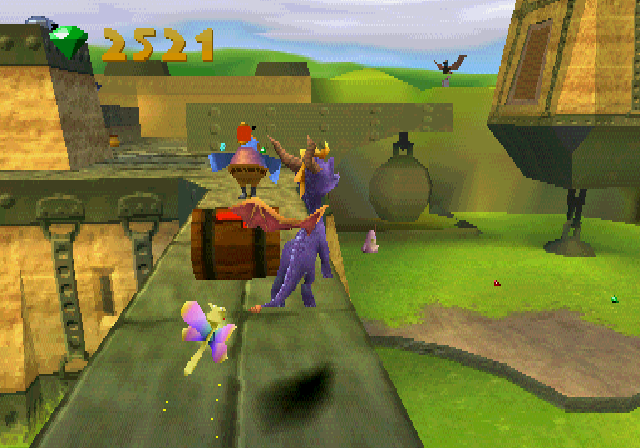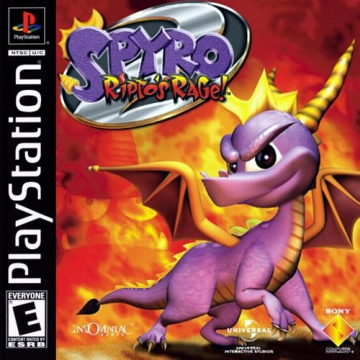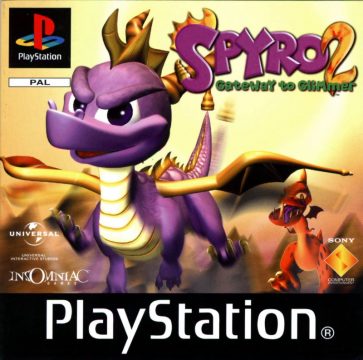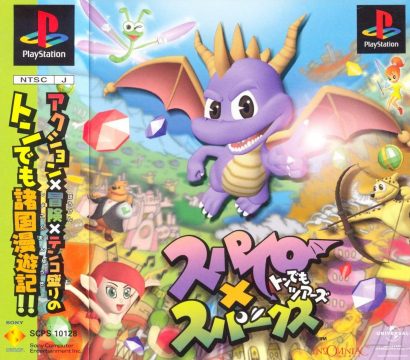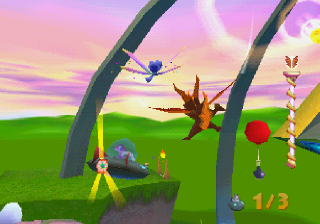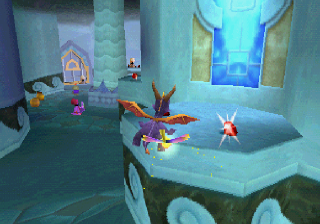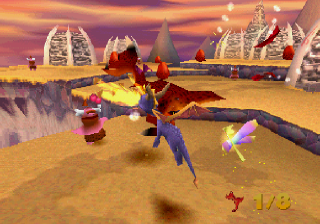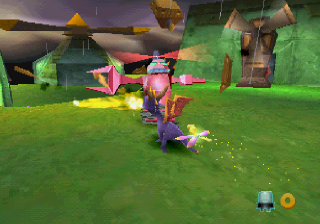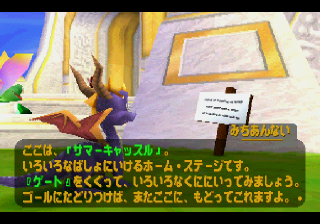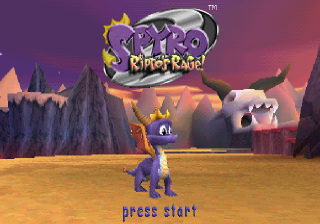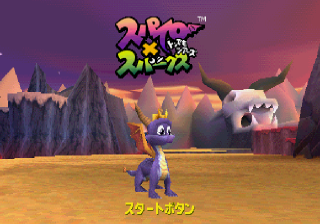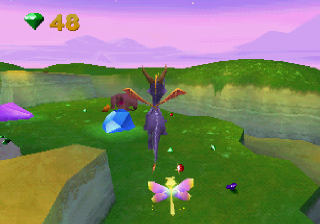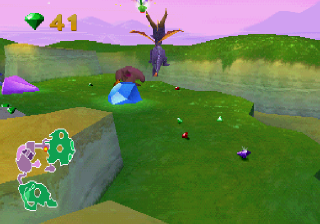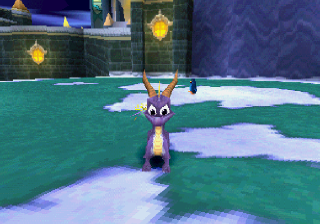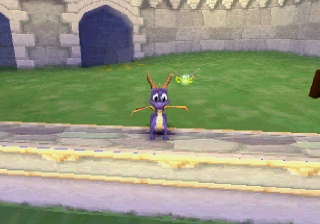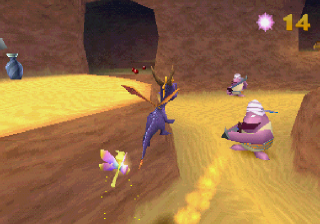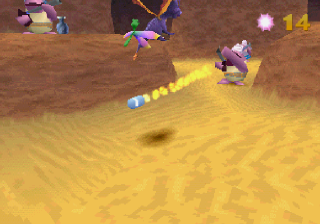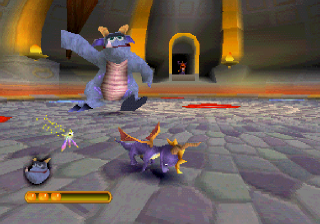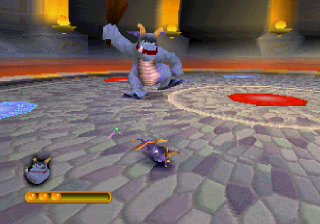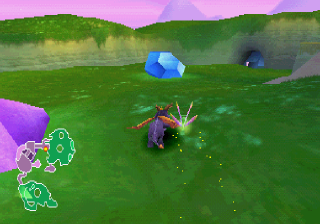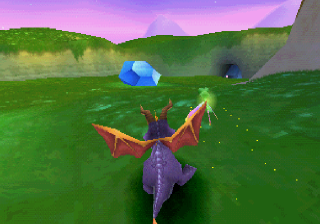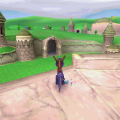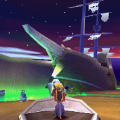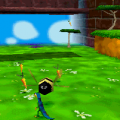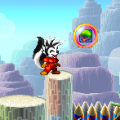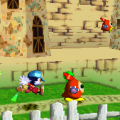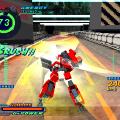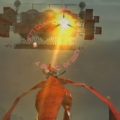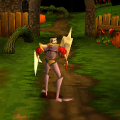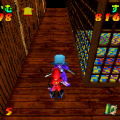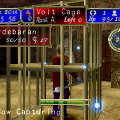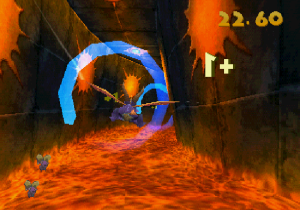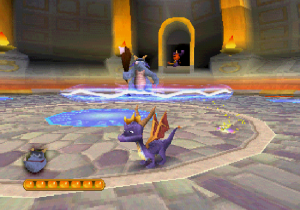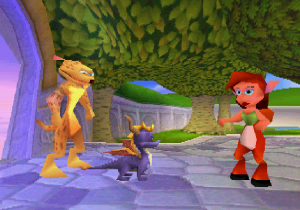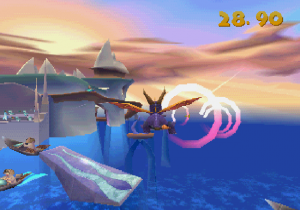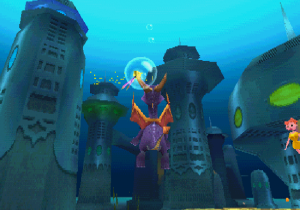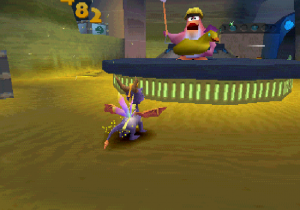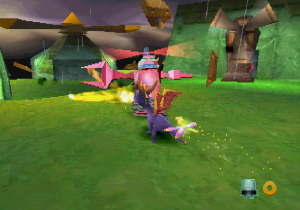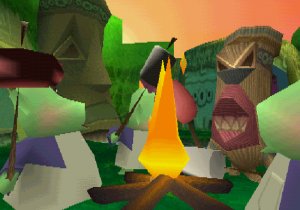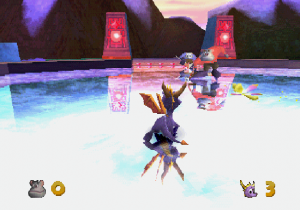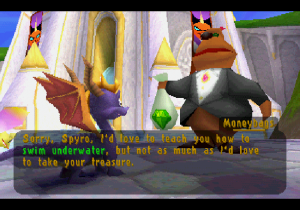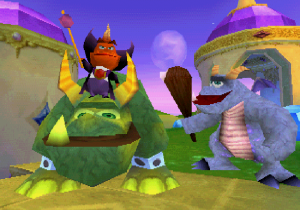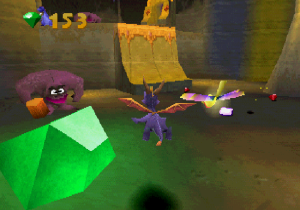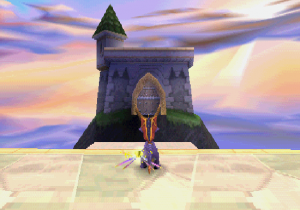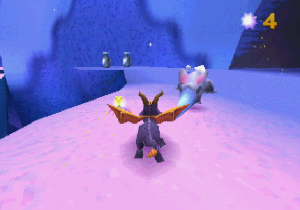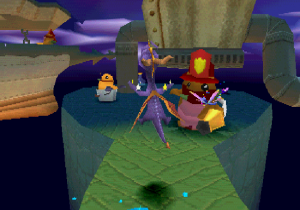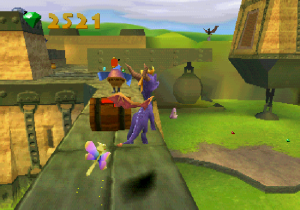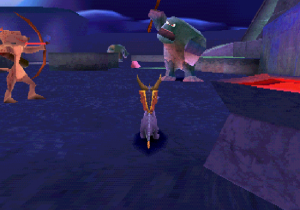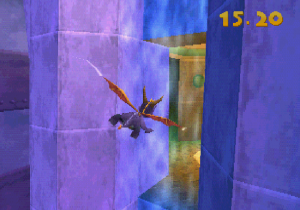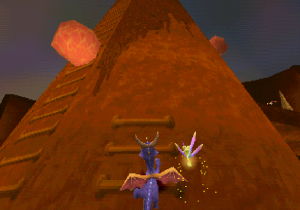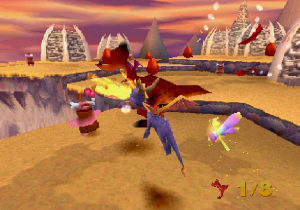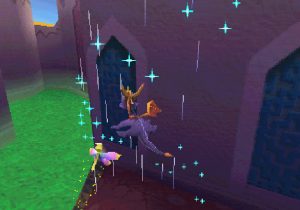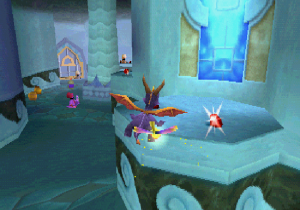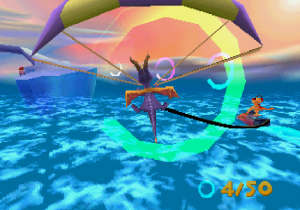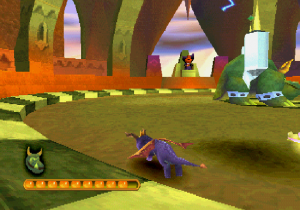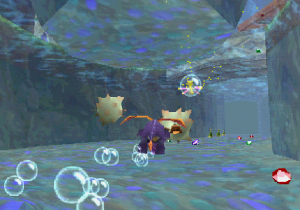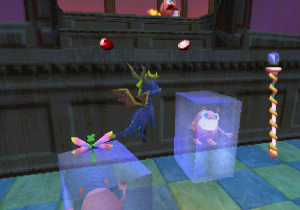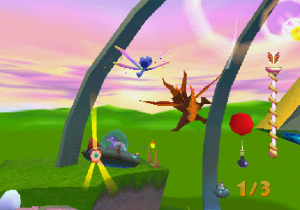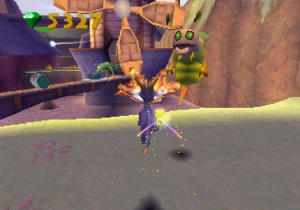- Spyro the Dragon
- Spyro 2: Ripto’s Rage
- Spyro: Year of the Dragon
- Spyro: Reignited Trilogy
Spyro the Dragon was a smash hit upon its release, so it’s not too surprising that a sequel was soon underway. But instead of delivering more of the same, Insomniac sought to address criticisms of the original’s often repetitive nature by dramatically changing the game’s structure. Released just over a year later, Ripto’s Rage is a very different game that retains the great gameplay, but more refined and with greater variety.
It’s been raining in the Dragon Realms for ages, and Spyro decides to take a vacation in sunny Dragon Shores. He heads into the portal, but gets whisked away to a distant land called Avalar, which is currently under threat from the evil wizard Ripto and his goons Crush & Gulp. He’d been brought over by the Professor, Elora and Hunter as a miscalculated attempt to defeat Ripto with a powerful dragon, but he nevertheless decides to help solve Avalar’s problems and kick Ripto’s butt (and maybe find a way to Dragon Shores).
Ripto’s Rage has the same gameplay as the original, but Spyro’s controls have been considerably tweaked. Turning while charging is much tighter, which makes it easier to hit targets and avoid charging off cliffs. He can’t roll anymore (though this move was featured in early demos), but he can now hover at the end of a glide, giving you enough height to help you reach tricky platforms. In addition, Spyro no longer gets hurt by water, which ties into the new moves he can acquire.
By paying the greedy bear Moneybags with gems, you can unlock the ability to swim underwater, climb up walls marked with ladders, and do a downwards headbash that destroys breakable objects. The improved controls make the game more enjoyable to play, and combined with the removal of the chests that forced you to stop, it ensures the flow is much smoother. However, the new abilities don’t quite work as well. The swimming controls are really good, with the charging being expertly translated into underwater movement, and how seamlessly you can go from swimming to moving on land. But climbing is slow and headbashing stops you whenever you trigger it, which feels quite awkward.
Enemies don’t drop gems anymore, but beating enough of them in each level activates magic gates. These gates grant you temporary power-ups such as invincibility, free flight and supercharges. They’re not essential to completing levels, but are useful for creating shortcuts and beating side-missions, which ties into the game’s new focus.
Instead of collecting items, you complete missions for people you encounter in each world, which offer two different rewards. There’s Talismans, which you get by reaching the end of the level. In the first two of the game’s three hub worlds, you need to get the Talismans from every level in order to fight Crush and Gulp. Then there’s Orbs, which are earned for optional objectives such as beating minigames or finding hard-to-reach areas. They’re usually needed to open up the flight stages (now called Speedways), but you’ll need to collect plenty to fight the final boss. If you find everything, you might get a special reward for your troubles…
Because Talismans and Orbs act as rewards for missions than collectibles, the gameplay and structure of each level is much more varied. One stage can have you restoring bodies of water to make progress, while another sees you rescuing characters to open up new areas. Levels can still be as open as before, but they can also be quite linear. This especially applies to the Orb Challenges, which have you doing all kinds of tasks like playing hockey, platforming, and solving puzzles. This makes experiencing new worlds more fun, since you have no idea what you’ll find.
The focus on completing missions also makes the game more accessible. You can beat most of the game by getting the Talismans, while the variety of Orb Challenges mean you can still make progress by doing whichever ones suit your playstyle and skill level (a very nice touch is that these indicate the level of difficulty before you do them, helping you make a better choice). This even affects the level design. Most levels lack bottomless pits, and any that exist aren’t placed over platforming sections or near tricky areas, so you don’t have to worry about dying if you screw up. While the game’s overall accessibility was criticized at the time for making things too easy, its ability to help players of all kinds get involved and have fun far outweighs that issue.
However, the changes have their own issues. Designs don’t focus so much on platforming and worlds are physically smaller, which is partially due to most of them now featuring shortcuts to previous areas. It’s a good way of helping players backtrack easily, but it also means stages don’t approach the massive scope seen in the first game. This also affects the progression. You must beat every level to reach the next hub world, although you can tackle them in any order. Because you need to acquire abilities to reach certain areas, you’re encouraged to revisit worlds to try new missions, meaning that even experienced players can’t just breeze through everything. On the one hand, it incentivizes you to pay closer attention to what’s going on and retry challenging missions. But it also gives you less freedom in tackling the game, which can make replaying it a bit tedious.
Ripto’s Rage is different enough from the first game that it’s not universally superior, but it still makes some welcome quality of life improvements. Collecting gems is much easier, since Sparx can gather groups of them more quickly. The game now autosaves between levels, so you don’t have to worry about saving before quitting. Marking checkpoints is made easier thanks to the introduction of Zoe, a fairy who zaps you when you’re nearby.
The boss battles are considerably better. Though there aren’t as many as the first, they’re far more memorable thanks to how challenging they are. Instead of running away from you, they’ll employ a variety of tricky strategies and repeatedly change tactics as you deal more damage. Because of this, they’re now tense struggles that’ll give even veterans a satisfying challenge, which is further accentuated by the imposing arena designs and dramatic music provided by the game’s excellent presentation.
The graphics are still fantastic, but the character designs are much better (thanks to Oliver Wade, who handled the designs for this and its sequel by himself). Enemies are more easily defined, and have a greater ability to express themselves than before. This extends to the NPCs, who have a charmingly goofy variety of designs that instantly convey a sense of character that the previous game’s generic dragons didn’t.
Stewart Copeland returns to do the music, but it sounds quite different. This is partially because the soundtrack features an extensive use of loops from Distorted Reality 2, a pack of music samples that were often used in various American TV shows, films and games in the late 90s/early 00s. Combined with the move away from pop rock, this gives the music a more ambient vibe. There’s a greater variety of genres and styles covered, which makes each track more distinct, while the returning instrumentation and compositional techniques help provide a soundtrack that’s both familiar and fresh. An unexpected improvement comes from the sound design, with many of the sound effects being redone to make gem collecting, charging, breathing fire, ramming enemies and the like far more satisfying.
The story and characters are given considerable focus, with an emphasis on talking to NPCs and helping them out with their troubles. This is done with amusing dialogue scenes, nicely performed by a cast of experienced voice actors such as Tom Kenny (the voice of SpongeBob SquarePants, who also takes over as the voice of Spyro), Gregg Berger, Milton James, Marcelo Tubert and Melissa Disney, and silent comedic cutscenes that bookend each level to show their state before and after Spyro’s intervention. Combined with various references made to other levels and the way stages share similar NPCs and themes (e.g. the warring factions in Zephyr and Breeze Harbor), this all helps to make Avalar feel like a tangible community in a way most platformers didn’t at the time.
A new addition are Skill Points, which are earned by completing a variety of optional tasks like beating speedways within a time limit or fighting a boss without getting hit. These act much like the Achievement/Trophy system introduced in the seventh generation of gaming, and would appear in every Insomniac game from here up until near the end of that era. Skill Points aren’t mandatory to completing the game, but they’re how you unlock the post-game Epilogue, which consists of goofy things the characters get up to, along with a gallery of presumably scrapped enemies.
Like the first game, Ripto’s Rage got a Japanese release that made substantial tweaks to the gameplay and presentation. It’s not as good as the worldwide version, but it genuinely addresses enough criticisms from the original’s localization to make for an interesting interpretation that’s still enjoyable to play.
As the name of Spyro X Sparx suggests, Sparx has been given some extra emphasis, as he now talks in cutscenes (voiced by Ai Satou, perhaps best known for voicing Mariko Juumonji in the long-running Ojarumaru anime adaptation). The cutscenes are considerably more talkative, with the level-specific cutscenes featuring commentary from Spyro, Sparx and other characters about what’s going on.
The character designs have been slightly tweaked, with many characters such as Hunter getting a different eye color. This even applies to Spyro’s in-game model, which loses the American version’s angry eyes for a more neutral expression (something the European release also did). In other graphical details, the font has been changed to a more interesting shiny gold typeface, while the world-level suffix has been dropped from the now faithfully translated level names.
Once again, you can find dragonfly eggs hidden throughout the levels if you have the PocketStation plugged into one of the memory card slots. Finding these eggs will give you dragonflies that you can raise, train, breed and fight through the PocketStation. The infamous signposts also return, but they only appear in the hub worlds and are now activated by talking to them, which makes them much less annoying.
The controls have been changed, though they’re nowhere near as bad as the first game (mostly). Trying to turn while charging is still a little laggy, but your overall speed is the same as the overseas version. Sadly, the same can’t be said for the underwater controls, which have been changed so you now have to press the charge button instead of holding it to move quickly. Spyro just moves forward briefly before suddenly stopping, and there’s a significant delay that prevents you from rhythmically pressing the button to keep moving. It’s a needless change that makes one of the game’s best additions an aggravating chore.
The camera is still zoomed out, though it’s much closer to Spyro now. This means you can see things more easily, and the game doesn’t have to cut or restrict your view whenever you go indoors. Annoyingly, the camera still doesn’t rise with you when you jump (except for boss battles), making higher platforms or enemies harder to see. However, the best thing about the camera is that there’s an option in the menu to change it back to the original camera. This alone makes the Japanese version much more playable, and worth checking out for anyone who’s curious about the presentational changes.
However, this was the last game in the original trilogy to be released in Japan. Perhaps it was due to the extensive localizations (which resulted in the games coming out months after their Western counterparts) and poor sales (the original barely broke over 56,000 units), but for whatever reason, it was decided to not localize what would be Insomniac’s last game in the series, Year of the Dragon.
(Screenshots of the PocketStation game were sourced from the Spyro Wiki: https://spyro.fandom.com/wiki/Main_Page)
